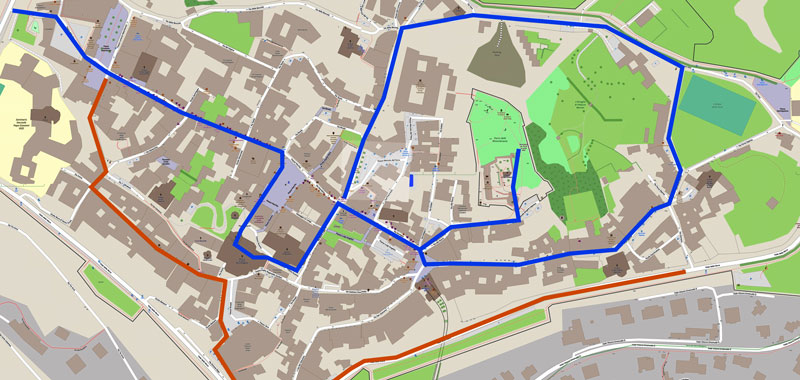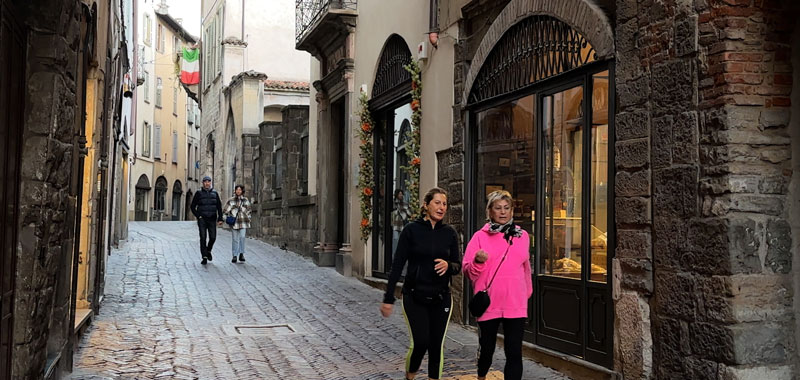
There is one main pedestrian street that runs through the center of town, Via Colleoni which then changes name to Via Gombito. This nicely paved lane is quite level, so you could walk its one kilometer from one end of town to the other in about half an hour. But there is so much to see, it could take you two days, especially wandering along some of those steeper little side lanes.
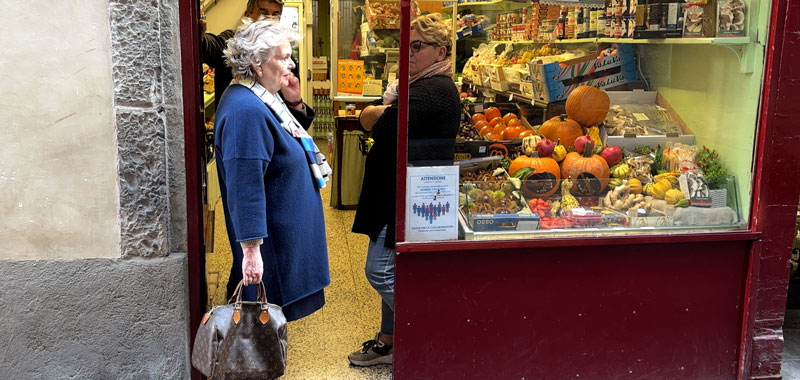
The authentic character of this place is seen in that small-town atmosphere, with local residents doing their shopping, chatting with neighbors, and relaxing out in the public spaces.
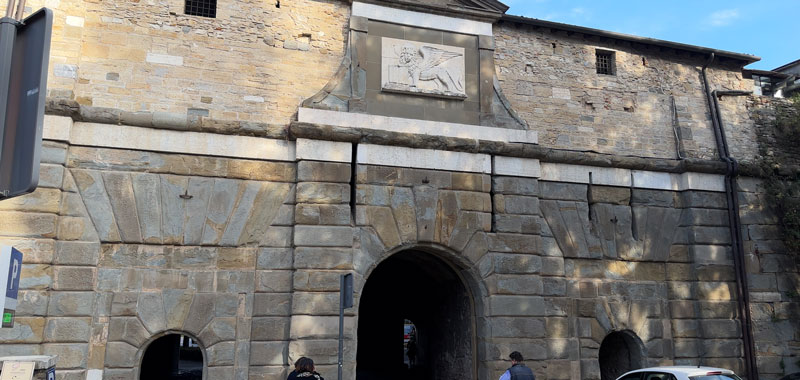
Begin the walking tour on the west end of town at Porta Sant'Alessandro, a monumental gate through the wall built by the Venetians between 1565 and 1575 to provide access into the upper town for those coming from Lecco and Como in the west. You'll see the winged lion on the gate’s upper section, one of many monuments created by the Venetians during their three centuries involvement with the city. More than just a gate, it's part of a larger square stone structure around Piazza Cittadella, with occasional markets taking place.
The Civic Archaeological Museum is also located on Piazza Cittadella. Visiting the museum is like going on a journey across the history of Bergamo and its territory, from its prehistoric background to the Langobardic domination in the Middle Age. From stone axes to iron swords, from Celtic bronze ornaments to Lombard gold crosses, from cinerary urns to Roman tombstones and then ceramics, glass, sculptures and mosaics....A journey through time on the trail of the Celts, the Romans and the Lombards who lived in Bergamo and in the territories of the Province.
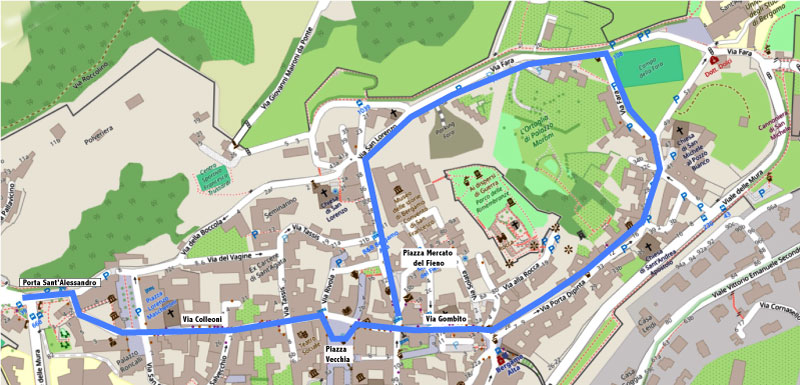
The route goes through the heart of town along Via Colleoni and Via Gombito, from one end of the Old Town to the other, passing beautiful shops, restaurants, little hotels, and piazzas along the way, then a bonus extension along the back part of the Venetian fortified wall.
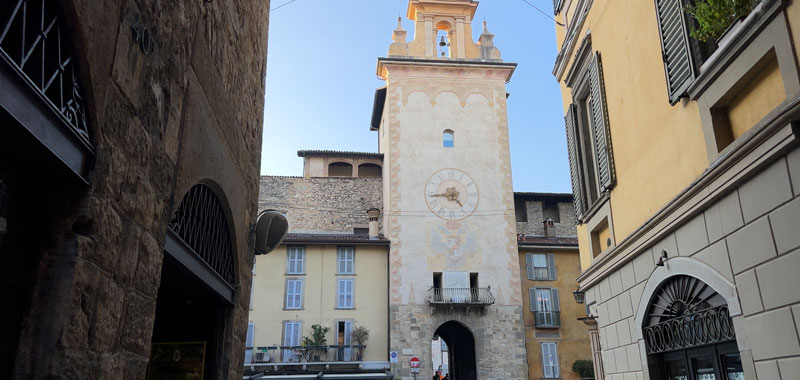
Torre della Campanella or Bell Tower was also part of the medieval fortifications. It leads into Piazza Mascheroni, a pleasant square with some restaurants, and the ancient water storage cistern was underneath. This piazza is at the beginning of the main pedestrian street of town, Via Colleoni, also affectionately known as Corsorolla, named after the renowned 15th-century mercenary captain, Bartolomeo Colleoni, who lived here and founded his charitable institution in 1466, which is still functioning today on Via Colleoni,
We've only just begun the main walk, but perhaps you're getting hungry already. Of course Italy is world-famous for its delicious cuisine, and here you will have many fine choices. Look for a painted halo suspended over the lane because not only does it lead you into a nice restaurant, but they have hotel rooms upstairs. It's the type of place called a loconda, as the manager explains.
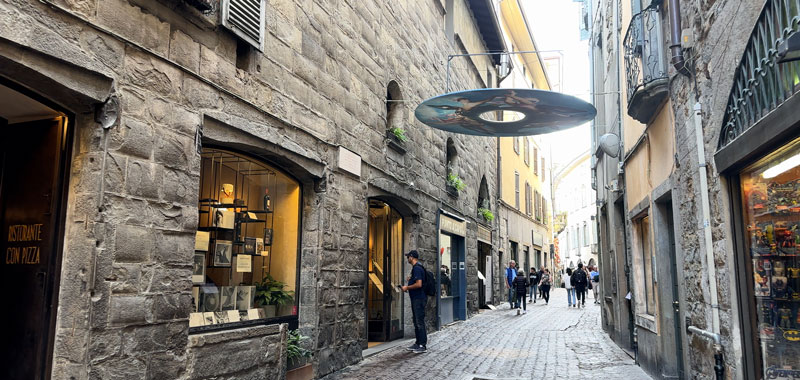
"So the name is Locanda Mimmo. It's not a hotel, it's just a locanda. Locanda means like it's, just this service because we have a restaurant upstairs. This is a restaurant, Mimmo, that is a historical restaurant. And we also have six rooms upstairs, two apartments, a freestanding room, and one suite." Staying at Mimmo would be ideal because you're right in the middle of the Old Town on the main lane, with a hotel room and a restaurant downstairs.
While walking along and getting a little more hungry, one particular restaurant caught my eye right on the main lane, Vineria Cozzi, founded in 1848. When I saw a policeman coming out from his lunch, I knew this must be the real deal. Cozzi provided a unique culinary experience on the most enchanting street of Bergamo Alta.
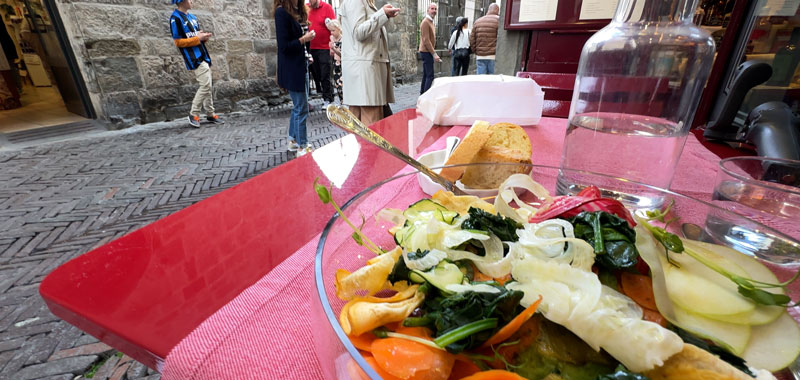
I was able to grab the table, which is about the only outdoor table on Via Colleoni. I decided to have a light lunch with their special salad, presented so beautifully, with carrots, fennel, quioja beets, pear, zucchini, golden beets, spinach, potato with basil cream, pea shoots and goat cheese. This is a perfect spot for a meal combined with people-watching. After that delicious culinary experience, I did not leave much on the table. There are several big rooms inside the restaurant, and an extensive menu with porcini tagliatelle, a stuffed ravioli, fresh polenta from Bergamo, beef cheek, deer rib, sausage, hamburger, duck, duck, duck, roasted octopus and mixed vegetables. Continuing along on Via Colleoni, you'll notice more restaurants, and a small, local food market, their version of a supermarket in a little shopfront.

Upon reaching Piazza Vecchia the same road now changes name to Via Gombito, leading towards the east side of town, similar to what you saw earlier with more shops and restaurants. Look at our separate page with detailed description of this grand piazza.
The tourist information office is nearby, so stop in and get some free information and brochures. It's located right next to the Gombito Tower, so you can't miss it at the corner of Via Gombito and Via Lup, just around the corner from Piazza Vecchia.
Via Gombito arrives in a few blocks at Piazza Mercato Delle Scarpe, once a thriving area of trade at an important intersection of six streets, where the roads from Venice and Milan met in the medieval period.
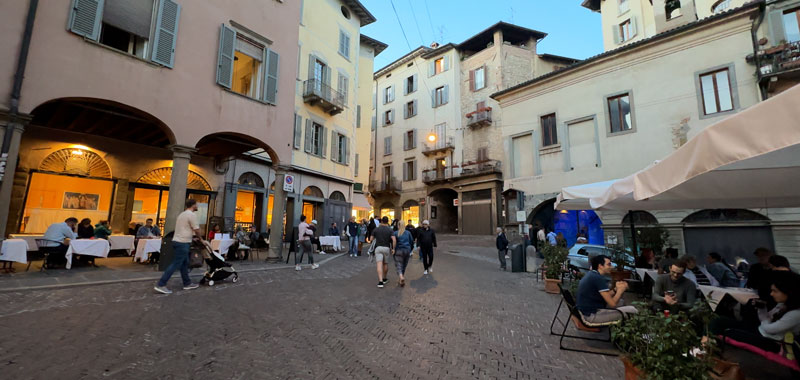
Explore the piazza and the little lanes around it to investigate the restaurant possibilities. There are many choices here in the piazza, and in those side streets. Perhaps enjoy a little pastry snack or the traditional kitchen in an old restaurant with barrel-vaulted stone ceilings. You can't go wrong in a place like that. Or maybe just relax in the piazza and have a spritz.
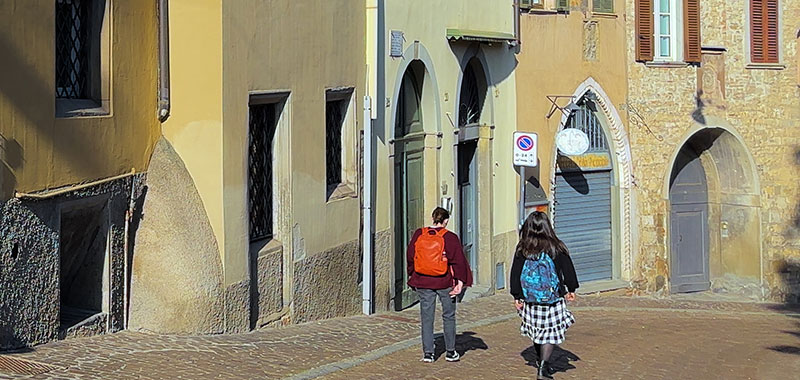
Via Porta Dipinta is one of six streets that emanate from Piazza Mercado. This is an important street that is essentially an extension of the same main lane we have been walking along. It is an easy-going downhill stroll, lined with grand buildings, each with portals that offer glimpses of gardens and terraces in the background. However, we have gotten beyond the restaurants and shops, so if you were hungry, it would have been good to eat back at the piazza. Along the way we pass Fontana Dipinta, located at what had been the eastern gate of the medieval walls of the city.
Palazzo Moroni is an eccentric 17th-century palace that has been very well preserved. The furnished interior is decorated with frescoes, many decorative objects and art masterpieces, as well as panoramic terracing and two hectares of agricultural grounds, now enjoyed as an extraordinary park in the heart of the upper city.
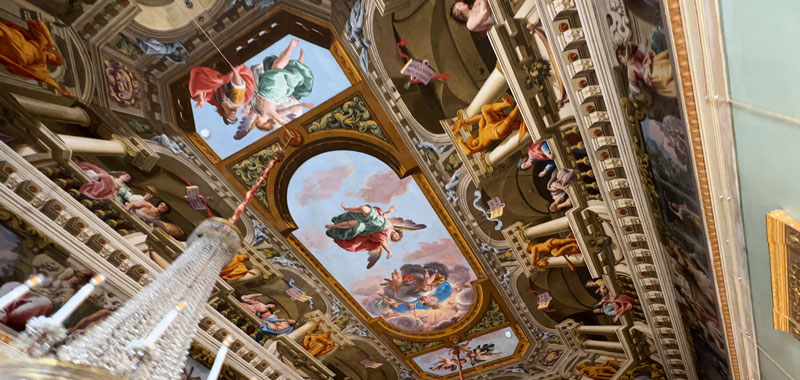
The interior boasts extravagantly frescoed walls with trompe l'oeil figures seemingly suspended from the ceiling, creating the almost psychedelic illusion of staring into a three-dimensional space with columns, arches, balconies, colorful costumes and angels flying through the air.
It's almost a forerunner of our 3-D movies or virtual reality goggles, except here you are, standing in the grand rooms of a palace, just looking with your own eyes at this amazing optical illusion.
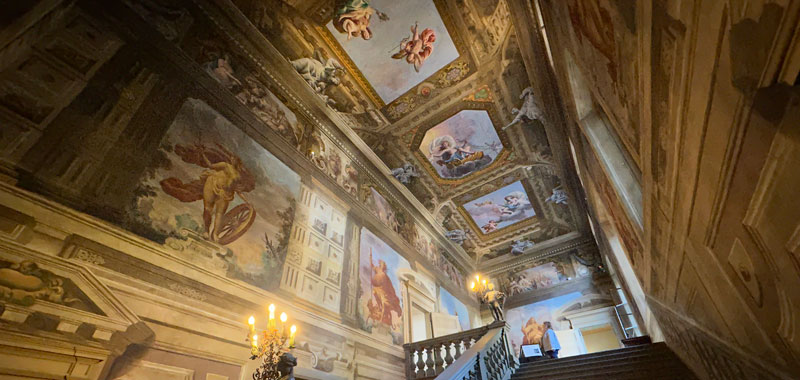
The Moroni family has owned and lived in the building since 1636. The original layout has been carefully maintained and preserved. A monumental staircase leads from the entrance courtyard upstairs to the rooms and halls, frescoed and furnished between the 17th and 19th centuries.
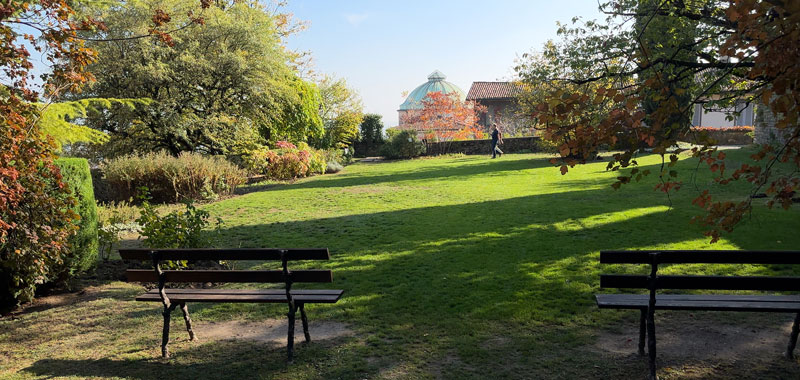
The back of the building opens up to stunning gardens that provide a welcome and peaceful respite from all of the dazzling frescoes in the interior of the palace. The rose-filled gardens and manicured hedges guide visitors towards a rolling meadow with views towards the mountains, and benches are conveniently placed for visitors to relax and soak up the lush surroundings. All in all, a surprising and delightful experience.
Continue on that same Via Porta Dipinta around the backside of town and along the way we'll see a few churches and more of the historic old buildings.
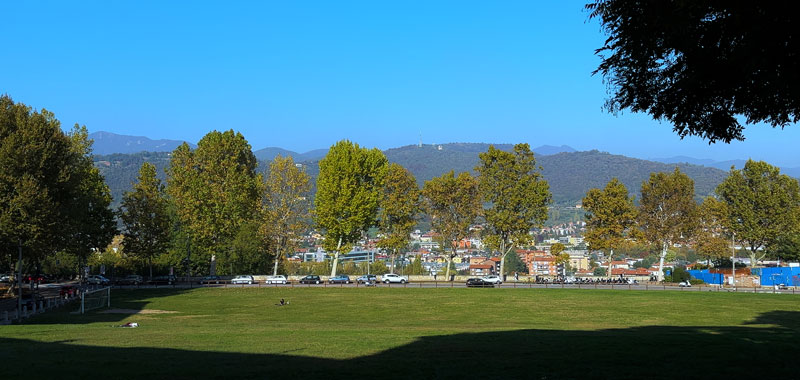
This lane is bringing us towards the east end of Bergamo Alta. In the old days, it had been a very important road because travelers from Venice to the east would enter the city along this street. The major fortified gateway in the wall was demolished a long time ago. But there is a little arch that will take us from the street, through a remnant of an old wall out into a meadow, Parco della Faro. On the right side of the lawn you’ll see Chiesa Sant'Agostino, founded in the late 13th century, now part of the University of Bergamo.
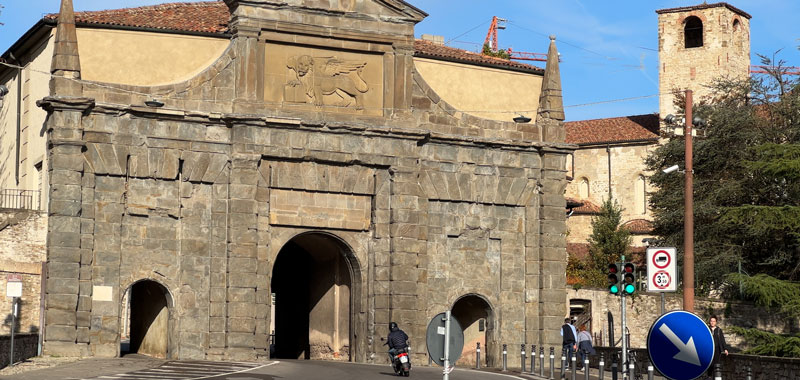
It's located next to the Venetian wall around town and the major gateway through that wall, which is Porta Sant'Agostino built in the late 16th century. It's still the most popular route for driving into the Old Town. There is a lovely pedestrian pathway next to the wall heading down to the modern city. At this point the main part of the walk is finished and you could go back the way you came into the town center.
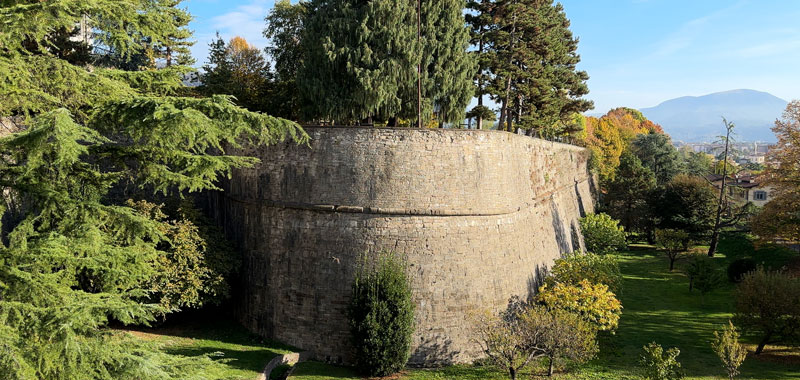
If you have time and energy keep going for another 800 meters on a path along the back portion of the Venetian wall, with more stellar views of distant hills. Some stretches of the walls were already there during the Roman era, but these walls were built in a 30-year period starting from 1561 by the Republic of Venice, especially to ward off attack by their rivals in Milan. The strategic position of Bergamo at the west end of Venice’s Italian territories caused it to be strongly fortified for defense.
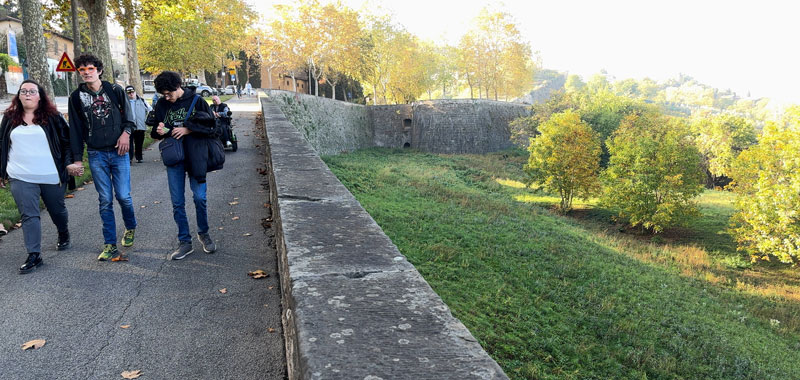
The walls consist of 14 bastions, 2 platforms, 100 embrasures for cannons, 2 armories, four gates, not to mention the underground structures featuring sallies, passages and tunnels. They reach heights of up to 50 meters at certain points. Today there is nothing martial about the fortifications, but they give the town air of majesty which it preserves with pride. They have been transformed into a magnificent promenade, shaded by fine trees, and are a UNESCO World Heritage site.
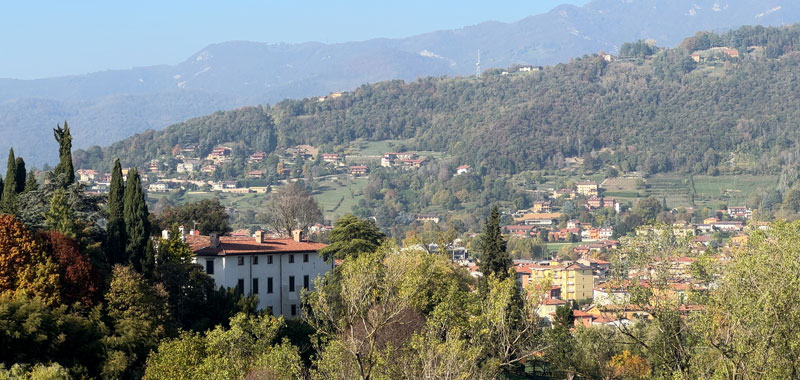
A walk on these ramparts is an exquisite experience, viewing landscapes that change like some gigantic scene on the stage. To the north there is a panorama of mountains where the picturesque chain of the Bergamasque Alps stretches out, dominated by the peak of the Tre Signori.
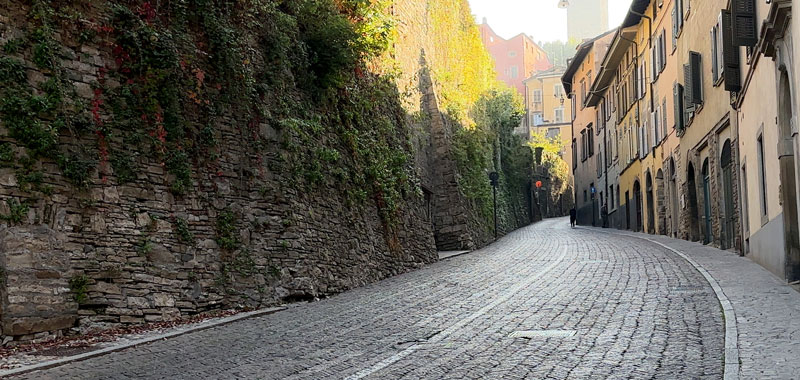
After walking about 500 meters along the wall you have seen the best part, so there is no need to continue any further, so turn onto Via San Lorenzo, which is a direct route slightly uphill, back into the center of the Old Town.
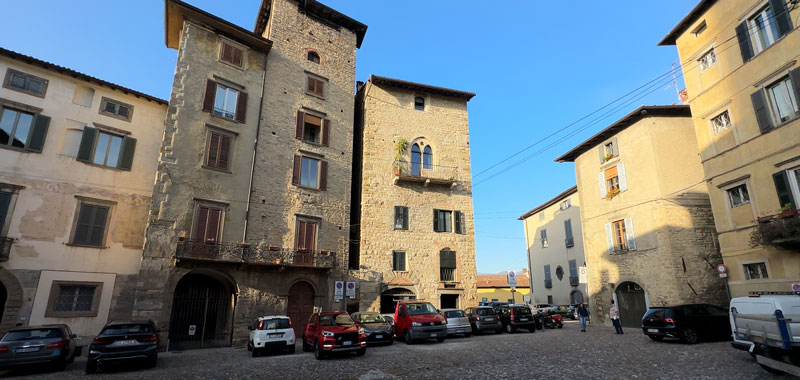
Mid-way along take a turn to the left where you find Piazza Mercato del Fieno, containing the former 14th-century Convento di San Francesco, and two impressive medieval tower houses. These houses, known as Casa Torre Calzani, were built in the 12th century, and are now private residences.
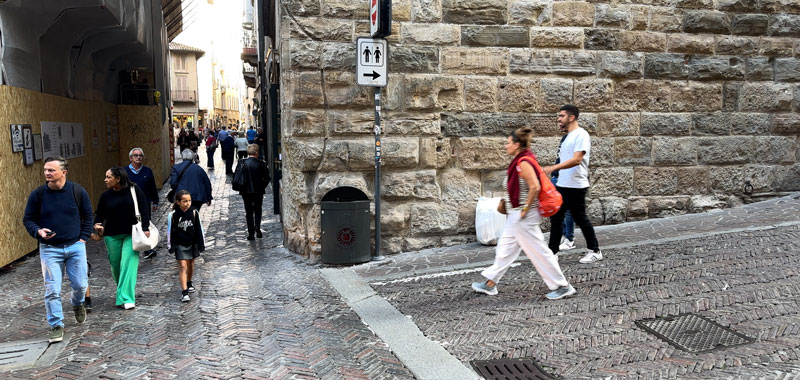
A few more minutes brings you back to the main lane of Via Gombito, near Piazza Vecchia, completing our main walking tour. Be sure to take the second walking tour in more little lanes and along the Venetian wall.
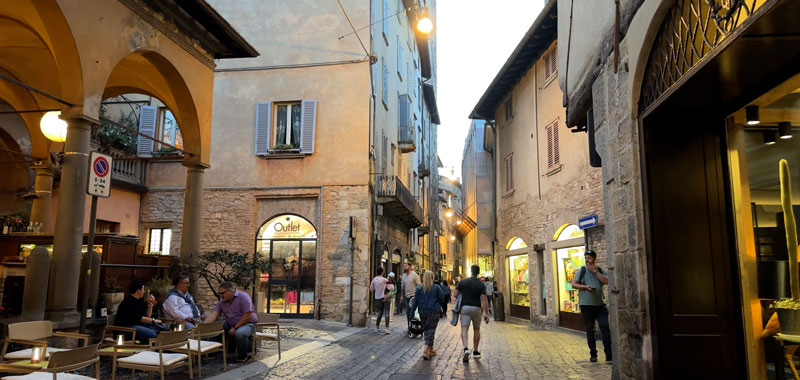
By now, you have probably worked up a thirst and an appetite. So hit one of these beautiful outdoor restaurants, or maybe just grab a pizza. Of course, you'll generally be better off sitting down and having a nice meal at a restaurant, such as at Al Donizetti, which has a beautiful outdoor pavilion reminiscent of the old markets of Italy like you'll find in Florence, with that lovely multi-arched loggia and outdoor tables right on our main street of Via Gombito.
Donizetti has a large wine list -- it's a wine bistro, after all, and they get mostly positive reviews. But any time you pick a restaurant, be careful: have a look around before you sit down and see if people are eating, check the prices. Ask around the neighborhood, in shops and elsewhere for restaurant recommendations, and then take your pick. Sometimes the setting, like an outdoor restaurant by a fountain, is as important as the food.
Now take walk 2 along some out of the way lanes that are equally fascinating, and with excellent views of the Venetian walls.
Map of walk 1, in blue, and walk 2, in red:
